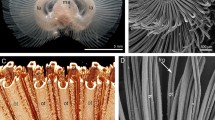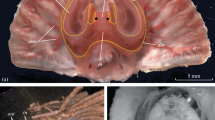Abstract
The ultrastructure of the lophophoral coelomic lining in the articulate brachiopod Hemithiris psittacea was studied using electron microscopy and confocal laser scanning microscopy. The coelomic system of the lophophore consists of large and small canals; both extend along each brachium. A small coelomic canal gives rise to a blind coelomic canal into each tentacle. The lophophoral coelothelium consists of two types of cells, epithelio-muscle and peritoneal cells, and exhibits different types of organization that is known in the Bilateria: from an epithelium consisting only of epithelio-muscle cells to a pseudostratified myoepithelium. The lophophoral coelothelium forms the musculature and blood vessel wall of the brachia and tentacles. The lophophoral blood vessel runs in the extracellular matrix of the septum that separates the large and small canals. In the lophophoral vessel, the upper wall consists of epithelio-muscle cells, whereas the lower wall is formed by peritoneal cells. The lophophoral vessel gives rise to blind branches into each tentacle. The lophophoral wall is highly muscular and contains both longitudinal and transverse muscles. Because the spirolophe lophophore of H. psittacea is supported only by short crura, the coelomic system of the lophophore is assumed to stabilize the lophophore by regulating the hydrostatic pressure of the coelomic fluid.










Similar content being viewed by others
References
Bartolomeus T (1994) On the ultrastructure of the coelomic lining in the Annelida, Sipuncula and Echiura. Microfauna Marina 9:171–220
Beecher CE (1897) Morphology of the Brachia. Bull US Geol Surv 87:105–112
Bulman OMB (1939) Muscle systems of some inarticulate brachiopods. Geol Mag 76:434–444
Cavey MJ, Märkel K (1994) Echinoidea. In: Harrison FW, Chia FS (eds) Microscopic anatomy of invertebrates: Echinodermata V14. Wiley-Liss, New York, pp 345–400
Dolmatov IY, Mashanov VS, Zueva OR (2007) Derivation of muscles of the Aristotle’s lantern from coelomic epithelia. Cell Tissue Res 327:371–384
Emig CC (1992) Functional disposition of the lophophore in living Brachiopoda. Lethaia 25:291–302
Gilmour THG (1981) Food-collecting and waste-rejecting mechanisms in Glottidia pyramidata and the persistence of lingulacean brachiopods in the fossil record. Can J Zool 59:1539–1547
Hancock A (1859) On the organisation of the Brachiopoda. Philos Trans R Soc Lond 148:791–869
Hoverd WA (1985) Histological and ultrastructural observations of the lophophore and larvae of the brachiopod, Notosaria nigricans (Sowerby, 1846). J Nat Hist 19:831–850
Kuga H, Matsuno A (1988) Ultrastructural investigations on the anterior adductor muscle of a brachiopod, Lingula unguis. Cell Struct Funct 13:271–279
Kuzmina TV, Malakhov VV (2007) Structure of the brachiopod lophophore. Paleontol J 41(5):520–536
Kuzmina TV, Malakhov VV (2011) The periesophageal coelom of the articulate brachiopod Hemithyris psittacea (Rhynchonelliformea, Brachiopoda). J Morphol 272:180–190
Kuzmina TV, Malakhov VV, Temereva EN (2006) Anatomy of the coelomic system of articulate brachiopod Hemithiris psittacea (Brachiopoda, Articulata). Zool Zhurn 85:1118–1128 (Russian)
Logan A (2005) A new lacazelline species (Brachiopoda, Recent) from the Maldive Islands, Indian Ocean. Syst Biodivers 3(1):97–104
Mashanov VS, Dolmatov IY (2001) Regeneration of digestive tract in the pentactulae of the far-eastern holothurian Eupentacta fraudatrix (Holothuroidea, Dendrochirota). Invertebr Reprod Dev 39:143–151
Peck LS, Rhodes MC, Curry GB, Ansell AD (1997) Physiology. In: Kaesler RL (ed) Treatise on invertebrate paleontology, Part H, Brachiopoda V 1 Introduction. The Geological Society of America Inc and the University of Kansas Boulder Colorado and Lawrence, Kansas, pp 213–242
Pross A (1980) Untersuchungen zur Gliederung von Lingula anatina (Brachiopoda). Archimerie bei Brachiopoden. Zool Jahrb Abt Anat Ontog Tiere 103:250–263
Reed CG, Cloney RA (1977) Brachiopod tentacles: ultrastructure and functional significance of the connective tissue and myoepithelial cells in Terebratalia. Cell Tissue Res 185:17–42
Reynolds WA, McCammon HM (1977) Aspects of the functional morphology of the lophophore in articulate brachiopods. Am Zool 17:121–132
Rickwood AE (1968) A contribution to the life history and biology of the brachiopod Pumilus antiquatus Atkins. Trans R Soc N Z (Zool) 10:163–182
Rieger RM, Lombardi J (1987) Ultrastructure of coelomic lining in echinoderm podia: significance for concepts in the evolution of muscle and peritoneal cells. Zoomorphology 107:191–208
Rudwick MJS (1970) Living and fossil brachiopods. Hutchinson and Co. Ltd., London, p 199
Schneider CA, Rasband WS, Eliceiri KW (2012) NIH Image to ImageJ: 25 years of image analysis. Nat Methods 9(7):671–675
Storch V, Welsch U (1976) Elektronenmikroskopische und enzymhistochemische Untersuchungen über Lophophor und Tentakeln von Lingula unguis L. (Brachiopoda). Zool Jahrb Abt Anat Ontog Tiere 96:225–237
Temereva EN (2015) Organization of the coelomic system in (Lophotrochozoa: Phoronida) and consideration of the coelom in the lophophorates. J Zool 296(2):79–94
Temereva EN (2017) Ultrastructure of the coelom in the brachiopod Lingula anatina. J Morphol 278:997–1011
Temereva EN, Kuzmina TV (2017) The first data on the innervation of the lophophore in the rhynchonelliform brachiopod Hemithiris psittacea: what is the ground pattern of the lophophore in lophophorates? BMC Evol Biol 17(1):172. https://doi.org/10.1186/s12862-017-1029-5
Temereva EN, Tsitrin EB (2015) Modern data on the innervation of the lophophore in Lingula anatina (Brachiopoda) support the monophyly of the lophophorates. PLOS ONE 10(4):e0123040
Temereva EN, Gebruk AA, Malakhov VV (2015) Demonstration of the preoral coelom in the brachiopod Lingula anatina with consideration of its phylogenetic significance. Zool Anz 256:1–6
Williams A, James MA, Emig CC, Mackay S, Rhodes MC (1997) Brachiopod anatomy. In: Kaesler RL (ed) Treatise on invertebrate paleontology, Part H, Brachiopoda V 1 Introduction. The Geological Society of America Inc and the University of Kansas Boulder Colorado and Lawrence, Kansas, pp 7–189
Acknowledgements
This study was supported by the Russian Foundation for Basic Research, Project no. 17-04-00586 and the Russian Foundation for Basic Research, Project no. 15-29-02601. The research was performed at the User Facilities Center of M.V. Lomonosov Moscow State University with financial support from the Ministry of Education and Science of the Russian Federation.
Author information
Authors and Affiliations
Corresponding author
Ethics declarations
Conflict of interest
This research is not in consideration or published elsewhere. All co-authors approve the submission of this manuscript. The authors declare that they have no conflict of interest.
Ethical standards
The use of brachiopods in the laboratory does not raise any ethical issues, and therefore approval from regional and local research ethics committees was not required. The field sampling did not involve endangered or protected species. In accordance with local guidelines, permission for collection of material was not required.
Rights and permissions
About this article
Cite this article
Kuzmina, T.V., Temereva, E.N. & Malakhov, V.V. Ultrastructure of the lophophoral coelomic lining in the brachiopod Hemithiris psittacea: functional and evolutionary significance. Zoomorphology 137, 257–272 (2018). https://doi.org/10.1007/s00435-018-0397-8
Received:
Revised:
Accepted:
Published:
Issue Date:
DOI: https://doi.org/10.1007/s00435-018-0397-8




